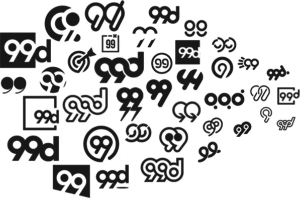99Designs of Logos on the Wall…

By democratizing graphic design, 99designs changed the balance of power and disrupted a dormant business
Starting a business has never been easier.
If you wish to kick start a business online, cheap computing resources are at your disposal from day one allowing you to minimize your capital expense and increase your focus on what matters most, creating real value for your potential customers. Finding that secret sauce that will make your product shine, standout from the crowd and capture the imagination, time, and (hopefully) money, of your customers.
This new world, filled with so many opportunities, allowing you to deliver your product or service from the comfort of a desk in your apartment or even a coffee shop table, also creates a new kind of challenge; how do you stand out? The battle for potential customers’ attention is greater than ever.
Visually appealing sites and applications are a must, but finding a designer, and furthermore, a designer whose creations you actually like, and at a reasonable price, is a real challenge.
99Designs.com comes to solve this problem, allowing access large groups of designers, creating a competition that incentivizes innovation and creativity, and gives you, the customer, a wide selection to work with.
How does it work?
When a new customer signs up and starts a project, she is prompted to choose between a few plans, varying in prices between $199 and $2,499, allowing for a different type of job (from logo, through tattoo, and all the way to an app or site), as well as access to different levels of service. The chosen plan price is, of course, also used for natural selection, where more esteemed designers auto

matically opt out of the cheaper projects.
After the plan choice is made the customer is prompted to choose sample styles that will help the designers focus their efforts, as well as provide information about the purpose of the design and the idea that has been “floating in their heads”. The more information provided, the higher the odds the results will answer your requirements. Once the competition is launched, it’s time sit back and wait.
Once designs start pouring in, the customer is called to action, filtering through entries, providing feedback and grading. Communicating back allows the designers to further iterate and improve their entries.
Once the desired design is found, all that’s left is to choose it as the winner, the designer gets paid and the customer receives the design as well as full copyright of it.
Does it work?
More than one would expect.
This innovative platform democratized the process of design, allowed customers greater selection through the power of crowdsourcing, and brought real change to an industry where customers previously felt like they were being held hostage by designers. Creating more access forces designers to be on the top of their game, better understanding the customer and their needs. In addition, it allows up and coming designers the opportunity to have access to jobs that were previously out of their reach.
With over 1.4M designers using the platform, and over 364k customers for which projects were completed, the platform is alive and kicking 9 years after it was launched. With $45MM in total funds raised, and $60MM in revenue in 2015, the company is pushing forward, allowing entrepreneurs access to services that were previously out of reach.




Great post Gil! What are the main challenges you see for their future? Does their business model attract designers sufficiently to all projects, or are they specializing in one segment (e.g. top tier?) How do they compete against other design platforms?
Interesting idea and post here Gil, thanks. It seems to me that there are some parallels here between their model and what Tongal does. From our in class discussion of Tongal, we noted that the crowd-sourced approach could require the customers to be much more involved than they used to (stages of selection, feedback, etc.). I wonder if this would be any different for a graphic design crowd-sourced company than it would be for a digital marketing company…
Thanks Gil, very interesting post!
It sounds like a perfect solution, particularly for new users who cannot afford the high fees charged by creative agencies. I wonder though what is the toll on the customer and their involvement in the project (i’d assume more than in traditional model as somebody needs to follow the process – similar to Tongal case) and as well, whether like in the case of Havas, this could be an acquisition target for a bigger scale creative agency to complement their offering.